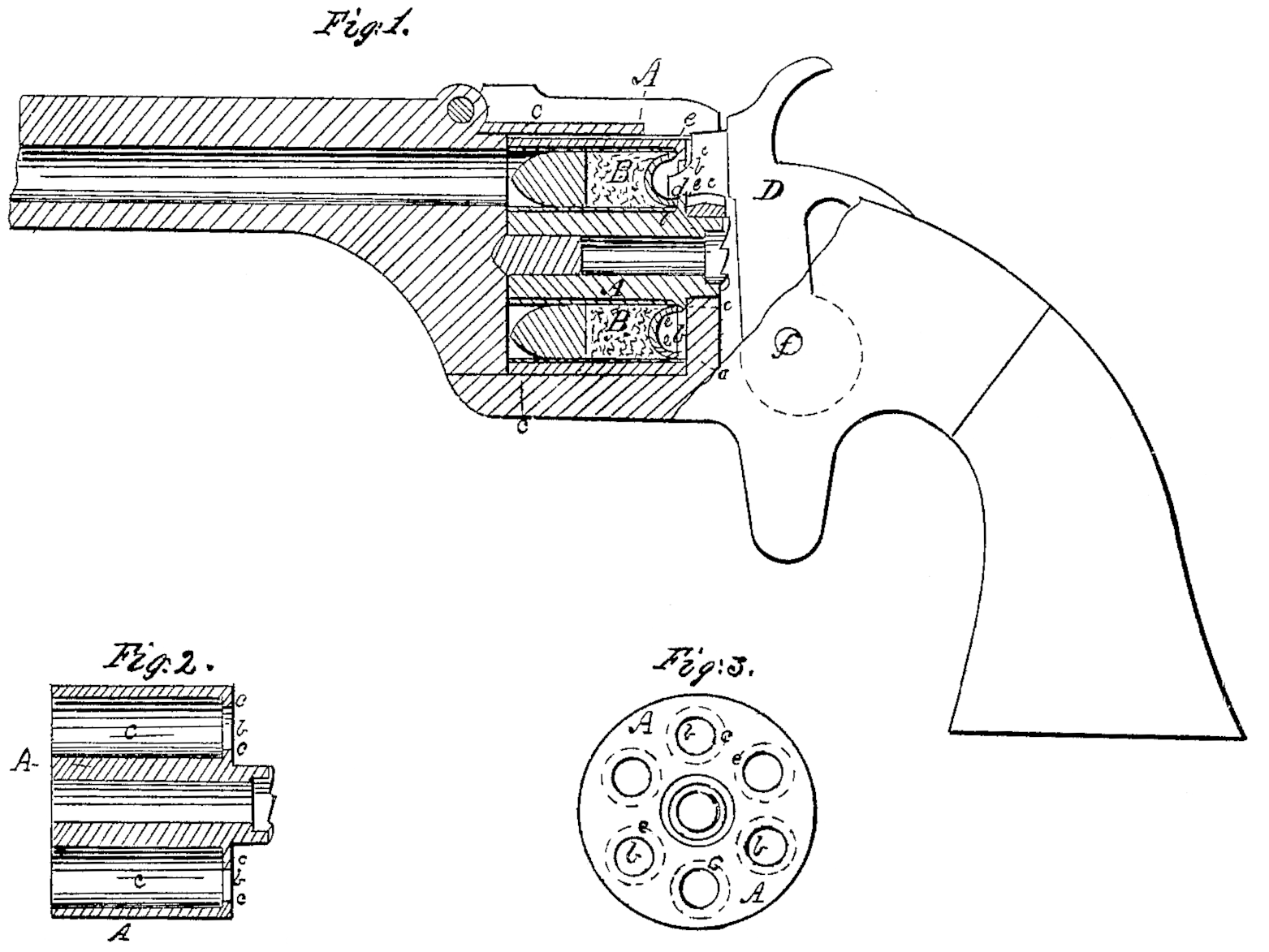US 39318
UNITED STATES PATENT OFFICE.
WILLARD C. ELLIS AND JOHN N. WHITE, OF SPRINGFIELD, MASSACHUSETTS, ASSIGNORS TO HENRY REYNOLDS, OF SAME PLACE.
IMPROVEMENT IN REVOLVING FIRE-ARMS.
Specification forming part of Letters Patent No. 39,318, dated July 21, 1863.
To all whom it may concern:
Be it known that we, Willard C. Ellis and John N. White, both of Springfield, in the county of Hampden and State of Massachusetts, have invented a new and useful Improvement in Revolving Fire-Arms; and we do hereby declare that the following is a full, clear, and exact description of the same, reference being had to the accompanying drawings, forming part of this specification, in which—
Figure 1 exhibits a central longitudinal vertical section of the cylinder, barrel, and part of the frame, and a side view of the hammer of a pistol with our improvement. Fig. 2 exhibits a central longitudinal section of the cylinder detached from the pistol. Fig. 3 is a front view of the cylinder.
Similar letters of reference indicate corresponding parts in the several figures.
This invention relates to revolving fire-arms to be loaded at the front of the cylinder with metallic cartridges carrying their own priming. To permit such cartridges to be inserted into the chambers in front they are made without the laterally-projecting flanges commonly provided, but have flanges projecting in a rearward direction Or parallel with the bores of the chambers to contain the fulminate priming.
This invention consists in a certain construction and arrangement of the openings provided in the rear ends of the chambers of the cylinder for the entrance of the lose of the hammer to strike the cartridges, and in a suitable arrangement of the hammer in combination with Such openings, whereby the hammer is caused to strike upon the interiors of the flanges of the cartridges, and the said flanges are supported against the blow of the hammer by the bores of the chambers without requiring any projections at the bottoms of the latter, such as form the subject-matter of Letters Patent, No. 24,726, thereby simplifying the construction of the cylinder.
To enable others skilled in the art to make and use our invention, we will proceed to describe its construction and operation.
A is the cylinder, having the chambers c c, of suitable size for the reception of the cartridges, bored from the front nearly to the back or bottom thereof, leaving only a sufficient thickness of metal at the bottom to support the cartridges B B. In the back or bottom of each chamber there is bored a concentric opening, b, which leaves a flange, c, all round the chamber, of sufficient width to form a bearing for the flange e of the cartridge.
D is the hammer, having its nosed made With a downward dip and otherwise so constructed and having its center of motion f so arranged that it may strike in a somewhat downward direction through the opening b of any chamber that may have been brought opposite to the barrel, and so strike upon the interior of the flange e of the cartridge in that chamber, in the manner illustrated in Fig. 1, for the purpose of igniting the fulminate priming contained therein and thereby firing the charge. This construction of the cylinder and arrangement of the hammer, besides simplifying the cylinder, has another advantage, viz: It brings the hammer more within the frame by bringing its head to a lower position.
To confine the cartridges to the flanges e of the chambers, their cases or shells are made of the full length of the chamber, and the barrel, or the front of the frame of the arm, is constructed to cover a portion of the front end of each chamber when the hammer is at full-cock and during its fall.
What we claim as our invention, and desire to secure by Letters Patent, is—
The construction of the openings b b in the chambers of the cylinder and arrangement of the hammer in combination with such openings, substantially as herein set forth, whereby the hammer is enabled to strike upon the interiors of the flanges of cartridges of such character as is herein specified.
WILLARD C, ELLIS.
JOHN N. WHITE.
Witnesses:
J. B. Upton,
James E, McIntire.

